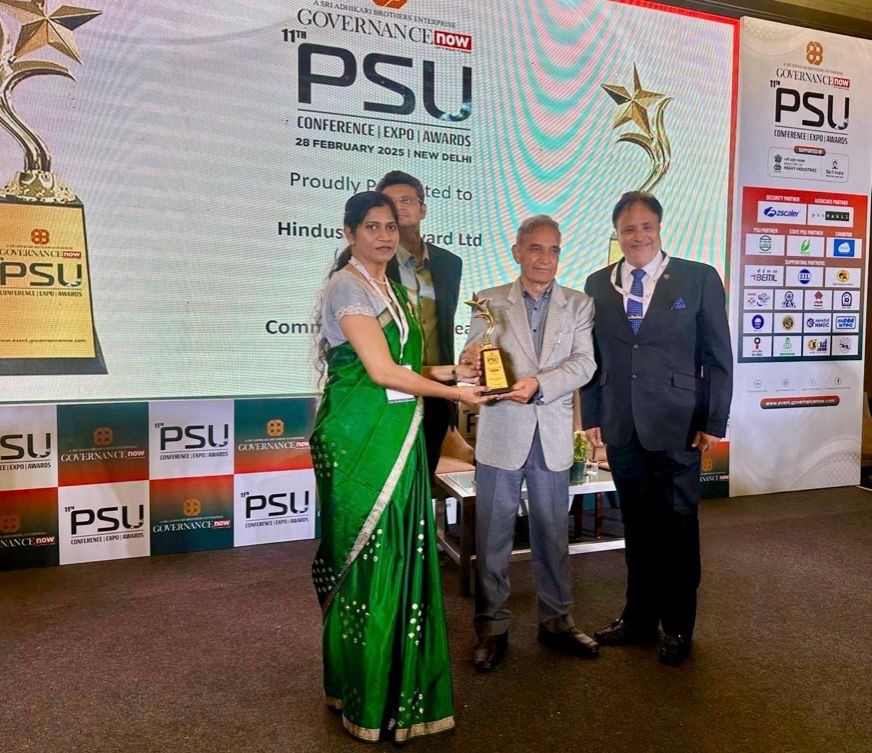synopsis
Hindustan Shipyard Limited (HSL) has won two key PSU awards, highlighting its growing role in India's maritime and defense sectors. With ambitious expansion plans, it aims for Mini Ratna status and greater self-reliance in shipbuilding and repair.
New Delhi: Nestled on India’s eastern seaboard, Hindustan Shipyard Limited (HSL) has long been a symbol of innovation and reinvention.
Established in 1941 as Scindia Shipyard, its legacy has been shaped by wartime exigencies, post-independence industrialisation, and a shifting global maritime landscape.
Now, as HSL secures two key recognitions at the “Governance Now” 11th PSU Awards, it is once again proving its ability to navigate an increasingly competitive and strategic domain.
The awards — ‘Operations Leadership’ and ‘Communication Outreach’ — highlight the country's oldest shipyard’s ability to balance technical expertise with an evolving business strategy.

In a sector where precision, timeliness, and reputational capital are paramount, these acknowledgements signal HSL’s growing stature within India’s broader maritime and defence ecosystem.
A Shipyard Steeped in Reform
For a company rooted in the mechanics of steel and seawater, operational efficiency is not just a metric but a matter of national interest.
Commodore Girideep Singh, Director (Strategic Projects) at HSL, was recognised for his leadership in ship repair and submarine refits, an area in which the yard has demonstrated significant improvements in recent years.
The timely completion of complex naval projects, particularly those involving critical underwater assets, has bolstered HSL’s position as a key enabler of India’s maritime readiness.
The ongoing Medium Refit and Modernisation (MRCM) of INS Sindhukirti, part of India’s ageing Kilo-class submarine fleet, reflects the technical strides the shipyard has made.
The project not only ensures operational continuity for the Indian Navy but also reinforces HSL’s ability to execute high-stakes refurbishments—an expertise that has historically been dominated by foreign yards.
In parallel, HSL has expanded its ship repair business, recording a 140% increase in revenue from this segment in 2024.
The repair and retrofit of commercial and naval vessels, including the INS Dhruv, India’s ocean surveillance vessel, has injected fresh momentum into its operations.
Maritime Strategy Meets Corporate Visibility
The second award, ‘the’ ‘Communication Outreach’ award, conferred on Neelima Boni, Senior Manager (Corporate Planning) and PRO, acknowledges a less tangible but equally critical dimension of shipyard management—brand positioning.
In an industry where government-owned enterprises often struggle with perception, effective communication can be as strategic as engineering innovation.
HSL’s expanding digital footprint, strategic media engagement, and growing presence in international defence forums have strengthened its business outreach.
As India seeks to establish itself as a global maritime hub, PSU shipyards like HSL will require technical credibility and an ability to attract partnerships, contracts, and investments.
By securing these recognitions in the Other PSU category, alongside Maharatna and Navratna companies, HSL signals its ambition to play a more prominent role in India’s maritime and defence-industrial complex.
Balancing Legacy with Future Ambitions
The awards also come at a critical juncture for HSL. The shipyard is on track to achieve Mini Ratna status by 2026, which would provide it with greater financial and operational autonomy.
With a Value of Production (VoP) target of ₹3,500 crore by 2034, its roadmap aligns with India’s Maritime Vision 2030—an initiative that aims to make India self-sufficient in shipbuilding and ship repair.
The ongoing construction of Diving Support Vessels (DSVs) and Fleet Support Ships (FSS) is evidence of the shipyard’s steady diversification.
Additionally, international collaborations, such as the INS Sindhuvir retrofit for Myanmar, highlight the potential for India to leverage defence exports as a geopolitical tool.
A Broader Strategic Role in India’s Maritime Aspirations
As the Indo-Pacific becomes the theatre of geopolitical contestation, the role of India’s maritime assets — both naval and commercial — will only grow in importance.
HSL’s continued expansion in submarine refits, auxiliary vessel construction, and regional ship repair contracts places it at the heart of this transformation.
While the Indian government’s push for self-reliance in defence (AatmaNirbhar Bharat) provides a policy tailwind, execution remains key.
The next phase of HSL’s journey will require balancing its government-mandated defence commitments with the agility needed to compete in commercial shipbuilding.
The latest awards are both a validation and a challenge. If HSL can maintain this trajectory, it could yet emerge not just as a shipyard of historical significance but as a forward-looking enterprise shaping India’s maritime future.
Also read: Air India fires simulator trainer pilot, 10 pilots grounded amid training lapse probe
)
 subscribe to Asianet News Whatsapp channel by clicking here.
subscribe to Asianet News Whatsapp channel by clicking here.